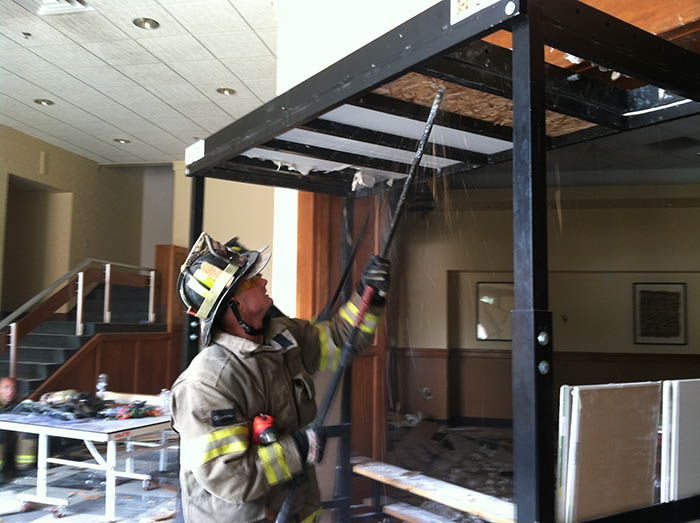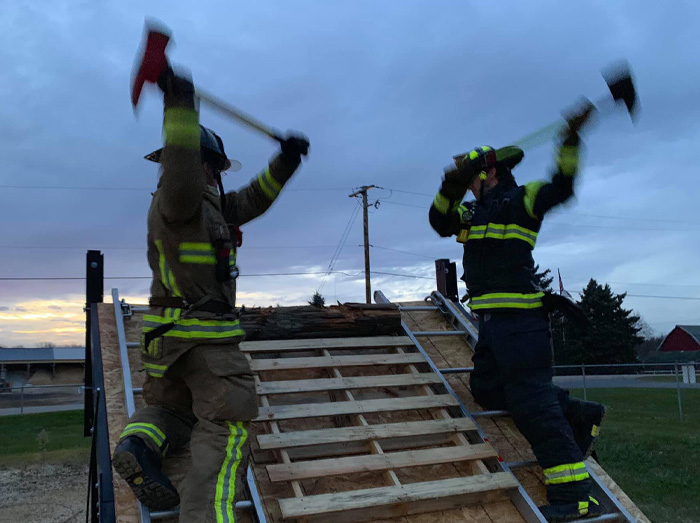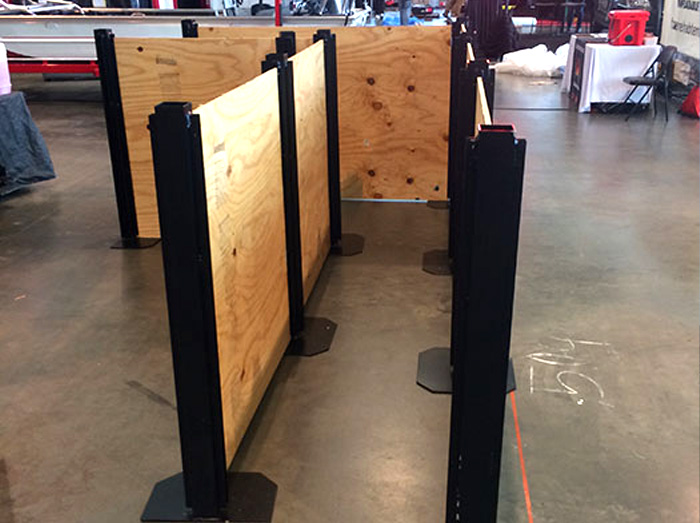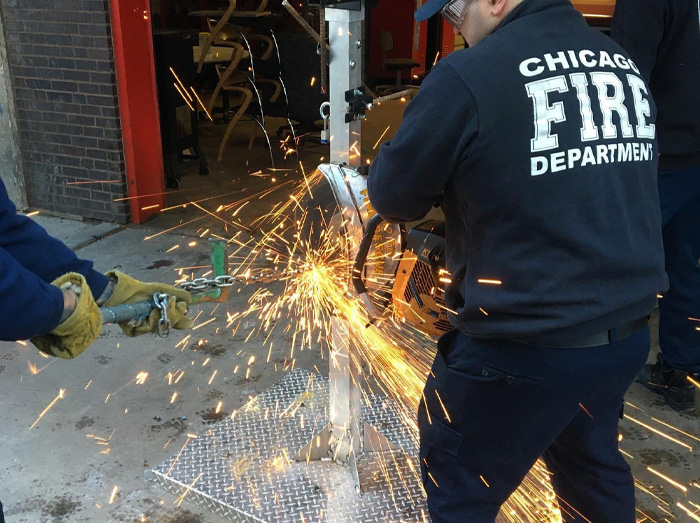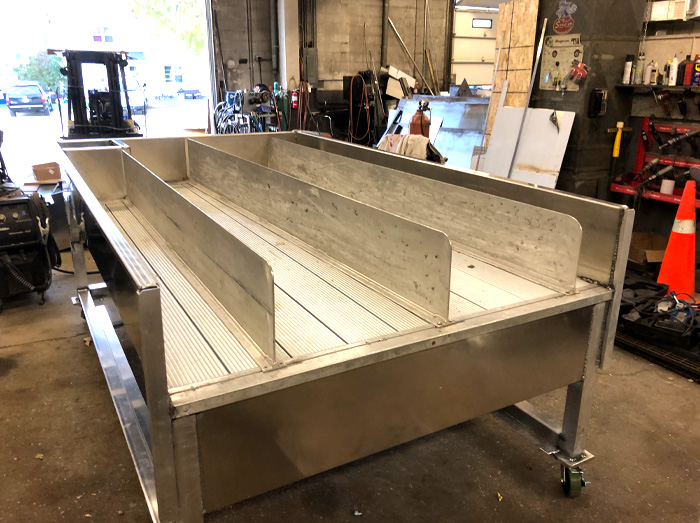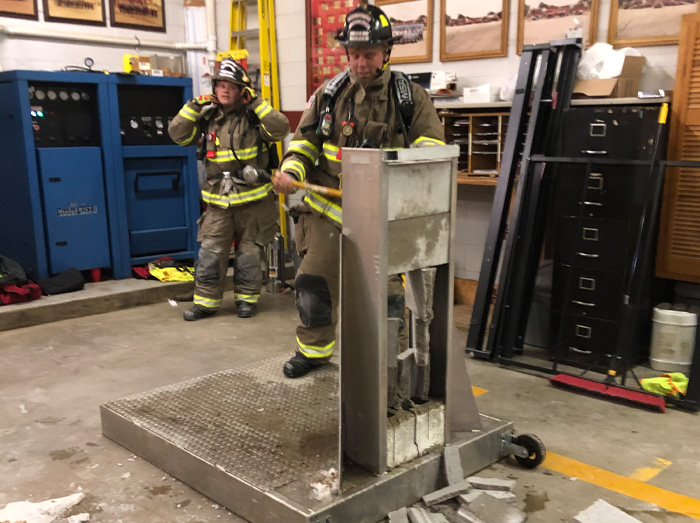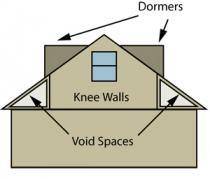King Training Innovations
Knee Walls
Published Monday, March 31, 2008 | From the April 2008 Issue of FireRescue
Editor’s note: In the following scenario, all names have been changed.
The engine and ladder truck swing onto the street lined with 1 ½ -story Cape-Cod-style houses. The engine drives past the house with smoke coming from the roof and noses into a hydrant in front of an adjacent property. The officer on the engine, Tom, grabs the mobile mic and advises, “Engine 42 and Truck 4—side A; one-story single-family dwelling. It looks like we have a small fire in the attic. Engine 42 with our own hydrant; have the second-arriving engine drop a line from Fordham.”
Tom doesn’t establish command because he knows the chief is right behind them; as soon as communications acknowledges the brief initial report, Tom hears the chief announcing his arrival: “Chief 4 on the scene. I copied 42. I’ll have the Ridge Avenue Command. Engine 42 is stretching a 1 ¾ line through the front door.”
Tom walks toward the house as his crew stretches the 1 ¾ attack line off the rear of the pumper. The street is still wet from a passing thundershower. He meets a frantic homeowner, who tells him the fire is upstairs, but everyone is out of the house. He passes this on to Command, who acknowledges and orders, “Engine 42 Mobile, charge the line.” A ground ladder crashes through the gable window as the engine crew advances the charged attack line through the front door. Smoke pours from the recently vented window.
The stairs are directly behind the front door. The firefighter on the nozzle, Allyssa, yells back to her officer as she reaches the top of the steps, “Hey, Cap! It’s pretty hot up here. I’m going right.” As Tom reaches the top of the steps, he realizes it really is hot. He hears another window shatter as he crawls into the bedroom to the right of the stairs. His ears are starting to burn. He can’t see the firefighter in front of him, but he knows she’s only 3 or 4 feet ahead. Tom sees a faint glow of flames overhead. Before he can say anything, he feels the line jump as the nozzle is opened up. The glow disappears.
Tom spins around and crawls back to the stairs. He hears the truck crew coming up the steps. He orders them to conduct a primary search on the left bedroom, returns to the first room and crawls all the way back to his firefighter.
“I think the fire’s in the wall!” Allyssa yells. Tom crawls up next to her and prepares to punch a hole in the wall in front of him with his Halligan. Suddenly, they hear muffled yells from far behind them: “Get out! Back out!” Tom and Allyssa spin toward the bedroom door. They hear a body falling down the stairs. Fire is blowing across the hallway from the other bedroom into the room where Tom and Allyssa are crouched. Allyssa spins her line around toward the door and blasts 150 gpm out the door, but within seconds, flames are rolling completely across the ceiling of the room. The heat becomes unbearable. “Get the hell out of here!” Tom screams and pushes her toward the door.
Allyssa drops the line, scrambles into the heavily involved hallway and tumbles headfirst down the stairs, landing on top of one of the truck crew. Tom and Bill, the truck captain, crash into each other at the top of the landing. Tom falls down the stairs; Bill lands in the bathroom at the top of the stairs, as his dislodged helmet bounces down the stairs with Tom.
Allyssa realizes what has happened and scurries back up the steps; she can hear Bill frantically crashing around the bathroom, screaming. At the top of the stairs, she feverishly pulls the hoseline back from the bedroom until the nozzle reaches her hands. She fires a straight stream off the ceiling of the fully involved hallway and bathroom; the hallway darkens. Suddenly, a body shoots out of the smoke toward her, crawls completely over her and crashes down the steps behind her.
As Allyssa retreats down the steps, she meets Tom at the front door. The air horns on the engine and truck blast continuously. Two firefighters from Engine 17 help Bill stand up and lead him outside. The chief yells, “Is everybody out?” Tom nods as he removes his mask: “We’re out, we’re all out.”
What Is a Knee-Wall?
Although it’s not immediately obvious, the above narrative describes a fire that went wrong because of a specific building construction feature: a knee-wall. Commonly encountered in the ½ -story portion (top floor) of wood-frame structures and other structures with peaked roofs, knee-walls are interior walls that extend from the floor to approximately chest height, where they meet the ceiling directly attached to the underside of the pitched roof. The major fire hazard associated with knee-walls: large, concealed spaces that contribute to the development of flashover conditions that can easily trap and burn firefighters (Figures 1 and 2).
Knee-walls enclose the lower end of roof joists behind a waist/chest-high interior wall. This creates a large, three-sided void space that can run the entire length of the structure, usually on both the front and rear (or both sides). A hip roof may have knee-walls on each side. In some instances, small doors are placed along knee-walls so occupants can use the area behind them for storage. The void space behind a knee-wall contains a significant fire load: exposed roof and floor joists, insulation, the underside of the plywood roof deck and combustible storage.
Fire enters the void space behind the knee-walls in one of the following ways:
- An electrical fire can ignite a fire in the void space;
- A contents fire on the top floor can extend into the void space;
- A fire on the floor beneath the top floor can extend through the ceiling into the void space or auto-expose out of the window directly under the soffit, causing extension into the void space; or
- A lightning strike can cause a knee-wall fire.
A fire in a knee-wall void space is more dangerous than typical fire extension into a studded wall. Fire in a studded wall will generally have slow lateral extension, because the interior wall surface and the exterior wall initially confine the fire between studs. A fire behind a knee-wall can instantly move in both directions: vertically between roof joists, and horizontally along the lower edges of the underside of the roof (across joists).
Size-Up
It’s important to determine if a structure has knee-walls upon arrival. Dormers rising from the sloped roof are an indication that the top floor is most likely an occupied space with interior walls—not an attic. Windows at the gables also indicate that the top floor is possibly an occupied space.
Take time to accurately size up the structure. Where is smoke coming from? Where is fire coming from? Does the location and amount of fire and smoke lead you to believe that you have a void space fire? Is there any structural compromise indicating the extent/ location of the fire?
If it’s apparent that the top floor of the structure or floor directly below is on fire, the initial incident commander (IC) and crews must determine whether the fire is in the void spaces created by the knee-walls. The following are exterior indicators that there’s fire in the void spaces:
- Smoke and/or fire from the soffit;
- Smoke from the lower corners of the gable;
- Fire burning through the lower edges of the roof; and/or
- Roof deck sagging between joists near lower edges.
Crews operating on the top floor of a structure that has fire in the knee-walls may face a number of different situations. If the fire started as a contents fire, the crews will advance upon what appears to be a typical room-and-contents fire. However, after the fire is knocked down, the rooms on the top floor will continue to contain oppressive, possibly untenable heat. Firefighters will be pinned to the floor. Horizontal ventilation of windows will provide little or no relief.
If the fire starts in the void space, first-arriving crews will likely face an intensely smoky fire. Crews will encounter near-zero visibility on the top floor. If they don’t realize the fire is in the knee-wall, they’ll search in vain for it. A structure in this condition is likely to flashover. Hopefully, firefighters are driven off the fire floor by the overwhelming amount of heat prior to such an event.
Some structures with knee-walls will also have a large void space under the peak of the roof. In these structures, the ceiling attached to the bottom of the pitched roof joists stop a few feet below the peak of the roof on both sides of the roof. A flat (horizontal) ceiling affixed to the collar beams spans the middle. A fire that engulfs the knee-wall void will quickly extend to the void space under the peak.
During size-up, estimate the distance between the top edge of dormer or gable windows and the peak of the roof. If there’s only about 3 feet between the level of the window and the peak, there’s probably no void space at the peak. However, if there’s more than 5 feet between the level of the top windowsills and the peak, there may be a void space below the peak.
To minimize the potential for injuries and efficiently combat fires involving these void spaces, personnel must employ heads-up strategies and tactics. The sooner we recognize a void space fire, the sooner we can devise an appropriate incident action plan.
Thermal Imaging
Thermal imaging cameras (TICs) can provide valuable information regarding the location of a knee-wall fire. During initial size up, use the TIC to assess the exterior of the structure, identifying heat signatures. Does the roof appear uniformly hot from the gutter line to the peak? If fire wasn’t attacking the void space, we’d expect the peak of the roof to be significantly hotter than the eaves. Are the lower corners of the gables hotter than the middle point of the top floor?
Upon entry, scan the ceiling of the floor below the fire. Are the outermost sides of the ceiling hot? These are the areas directly below the knee-wall.
As the attack line is advanced to the top floor, use the TIC to determine if there’s heat in the walls. This tactic will be useful when encountering smoke but little or no visible fire. Remember: There are usually two knee-walls opposite each other, but all four sides of the structure may have knee-walls.
Fire Attack
As with any incident, our primary and constant priority in a knee-wall fire is life safety. As your crew stretches the attack line to the fire floor and searches for fire and occupants, maintain constant situational awareness regarding fire conditions and your orientation within the structure. Regardless of whether you encounter actual fire, immediately assess knee-walls for possible fire, and position the hoseline to extinguish fire as the void spaces are breached.
Quite often, the top floors of these structures are congested and feature very tight hallways. The stairwell usually breeches the top floor near the middle of the structure, and there are bedrooms on either side of the top of the stairs (Figure 3). Deploy a second attack line to the top floor so two crews can search and extinguish on opposite ends of the structure. This can keep the fire from cutting off a single-attack crew if fire develops rapidly in the opposing bedroom.
Advise the IC if you do encounter fire behind the knee-walls. As the hose stream is directed into the confined space, it may push fire, heat and smoke out into the living space anywhere along the knee-wall, including the room on the opposite end of the house. As the fire is extinguished, continue to open up the knee-wall(s) to totally expose any hidden fire.
If conditions deteriorate on the top floor, retreat to the floor below. Hopefully, you’ll have had enough time to complete a primary search. Position as many handlines as necessary on the floor below (at least two) and open the ceiling along the front and rear of the house, directly beneath the void space. Open the ceiling from the exterior walls back toward the center of the structure until you reach the underside of the knee-wall. Extinguish fire in the void space.
Note: Fire can develop very quickly on the floor below if hoselines aren’t positioned and ready to extinguish the fire. Don’t start to open up until hoselines are charged and in place. After fire in the void spaces has been knocked down, you may be able to effectively advance attack lines on the top floor to complete extinguishment.
Ventilation
Ventilation tactics for knee-wall fires must be consistent with the fire-attack operation. For a top-floor fire, horizontal ventilation of the top-floor windows is the most efficient means of improving smoke/heat conditions on that floor. If the fire is in the void space, simple horizontal ventilation will not suffice, but you should still remove the appropriate windows on the top floor. This may enable interior crews to advance hoselines throughout the top floor and may allow them to extinguish fire in the void spaces.
If it appears the structure has a void space under the peak of the roof, vent the peak of the roof/ceiling over the bulk of the fire. Then, vent the knee-wall void spaces by cutting holes along the bottom edge of the roof.
Most structures with knee-walls have a relatively steep pitch. Always work from a roof ladder while venting the peak. The vent holes cut at the lower edges are very close to the edge of the roof. Do not attempt to cut these vent holes by standing on the roof; it’s neither safe nor easy to cut a vent hole on the bottom edge of a roof while standing on it (even with a roof ladder). Instead, cut two 3' x 3' vent holes while positioned near the top of a ground ladder—one to the left of the ground ladder and one to the right. Cut the downwind vent hole first. Additional ground ladders can then be positioned to cut additional vent holes in a similar manner (Figure 4).
If it appears there’s no void space under the peak of the roof, do not open the peak immediately. After horizontal ventilation, proceed directly to venting the knee-wall void space. You may also be able to effectively vent the void space by opening up the lower corners of the gables with a power saw. Place a ground ladder near the bottom of the gable, approximately 5 feet from the corner wall, then cut a triangular vent hole through the gable at the end of the void space (Figure 5).
Scenario Revisited
Using what we now know about knee-wall fires, let’s revisit the scenario from the beginning of the article. What could Tom have done to improve the outcome of this incident?
- First, Tom should have recognized that it wasn’t an attic fire, but rather a fire in an occupied half-story—an indication knee-walls likely exist.
- Using a TIC might have helped Tom identify the location and extent of the fire prior to/during entry. Perhaps he would’ve made different tactical decisions had he known the location of the fire.
- The amount of heat Tom and Allyssa encountered on the top floor was inconsistent with a small room-and-contents fire—an indication the fire was more serious than Tom believed upon arrival. This was an opportunity for Tom to reconsider attack options. Perhaps it was time to pursue a slightly less aggressive method of fire attack, such as retreating to the first floor and opening the ceiling beneath the void spaces.
- Despite the amount of heat, Tom directed the truck crew to search the opposing bedroom without a hoseline. When the fire erupted on the truck crew’s side, they were defenseless. But even an attack line might have rendered little protection in this flashover.
Conclusion
Many fire service educators subscribe to the notion that there’s no such thing as a “routine” fire. Every fire is different, of course, but that shouldn’t prevent us from labeling the fires we typically fight as routine. I’ve been to many incidents where we encountered room-and-contents fires, employed standard operating tactics and successfully controlled and extinguished the fire. These are routine fires. We forced entry, stretched lines, searched for occupants, performed ventilation, extinguished the fire, performed salvage and overhaul and we all went home.
The problem comes when we fail to recognize that a fire isn’t routine, or when, despite identifying non-routine conditions, we continue to employ standard tactics and strategies. This is when we get in trouble and firefighters get injured and killed. To protect ourselves, we must learn to distinguish routine fires from non-routine fires, and adjust tactics and strategies accordingly.
Knee-wall fires are non-routine fires. They present the firefighters with conditions that make extinguishment difficult and imperil interior operating crews. To safely combat these fires, officers must quickly identify the non-routine indicators of a knee-wall fire and take steps to protect their firefighters by continually assessing conditions and choosing the safest tactics.
Comment Now: Post Your Thoughts & Comments on This Story
Jonathan Hart
When you subscribe to the blog, we will send you an e-mail when there are new updates on the site so you wouldn't miss them.


